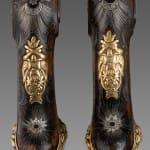Pair of Ottoman Double-barrelled Flintlock Pistols
Probably ISTANBUL, circa 1800-20
45.5 cm long
630a
Further images
-
(View a larger image of thumbnail 1
)

-
(View a larger image of thumbnail 2
)

-
(View a larger image of thumbnail 3
)

-
(View a larger image of thumbnail 4
)

-
(View a larger image of thumbnail 5
)

-
(View a larger image of thumbnail 6
)

-
(View a larger image of thumbnail 7
)

-
(View a larger image of thumbnail 8
)

-
(View a larger image of thumbnail 9
)

-
(View a larger image of thumbnail 10
)

-
(View a larger image of thumbnail 11
)

-
(View a larger image of thumbnail 12
)

-
(View a larger image of thumbnail 13
)

-
(View a larger image of thumbnail 14
)

Each with an upper and lower barrel, the wood stocks silver-inlaid with fine scrolls, flowerheads, sun and moon, with breech sections steel engraved and decorated in gold overlay, with repoussé...
Each with an upper and lower barrel, the wood stocks silver-inlaid with fine scrolls, flowerheads, sun and moon, with breech sections steel engraved and decorated in gold overlay, with repoussé decorated silver mounts in the antique style, each with two sets of makers stamps, the trigger guards and pommel spurs stamped with Ottoman hallmarks; the two barrels firing from a single lock by means of a double touch pan.
The Ottoman army began to become more Westernised in the early 1800s. The Turks at this time imported or imitated French flintlock pistols, known as kubur. The Metropolitan Museum of Art says that such firearms ‘had been introduced to the Islamic world by trade and armed conflict in both the East and West, and the manufacture of cannon and handheld firearms became a highly regarded craft in many regions under Islamic rule…. [They were] derived from seventeenth-century European prototypes in the construction of their locks and in the shape of their butts. Many were fitted either with European locks, acquired by trade or as booty, or with locks that were manufactured in Islamic regions but were in fact copies of European types.’ (“Islamic Arms and Armor.” In Heilbrunn Timeline of Art History).
A similar pair of pistols can be found in The Tareq Rajab Museum, Kuwait.
The Ottoman army began to become more Westernised in the early 1800s. The Turks at this time imported or imitated French flintlock pistols, known as kubur. The Metropolitan Museum of Art says that such firearms ‘had been introduced to the Islamic world by trade and armed conflict in both the East and West, and the manufacture of cannon and handheld firearms became a highly regarded craft in many regions under Islamic rule…. [They were] derived from seventeenth-century European prototypes in the construction of their locks and in the shape of their butts. Many were fitted either with European locks, acquired by trade or as booty, or with locks that were manufactured in Islamic regions but were in fact copies of European types.’ (“Islamic Arms and Armor.” In Heilbrunn Timeline of Art History).
A similar pair of pistols can be found in The Tareq Rajab Museum, Kuwait.














